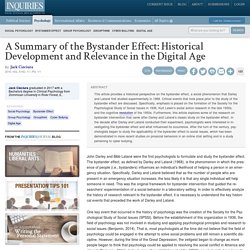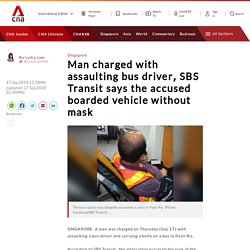

The Bystander Effect - Hook AP Psychology 1B. The bystander effect is defined as "when the presence of others hinders an individual from intervening in an emergency situation.

" If you've ever passed someone who looked in danger because you assumed someone else would come along to help, then you have fallen victim to the bystander effect. The most popular example of the bystander effect was the murder of New Yorker Kitty Genovese in 1964. While on her way home from work late at night, she was attacked and stabbed by an assailant. Over 38 people over the course of 30 minutes watched as her attacker returned again twice and stabbed her, the third time being a fatal wound. (Source 1) Kitty Genovese died after nearly 40 people had witnessed the attacks and failed to contact the police. According to researchers Latane and Darley, who performed the first studies involving the Bystander Effect after Kitty Genovese's death, there are five cognitive behavioral processes that a bystander goes through before deciding not to help. 1.) 2.)
Bystander effect. Winston Moseley, Who Killed Kitty Genovese, Dies in Prison at 81. While there was no question that the attack occurred, and that some neighbors ignored cries for help, the portrayal of 38 witnesses as fully aware and unresponsive was erroneous. The article grossly exaggerated the number of witnesses and what they had perceived. None saw the attack in its entirety. Only a few had glimpsed parts of it, or recognized the cries for help. Many thought they had heard lovers or drunks quarreling. There were two attacks, not three. But the account of 38 witnesses heartlessly ignoring a murderous attack was widely disseminated and took on a life of its own, shocking the national conscience and starting an avalanche of academic studies, investigations, films, books, even a theatrical production and a musical.
Darley, J. M., & Latané, B. (1968). Bystander intervention in emergencies: Diffusion of responsibility. Journal of Personality and Social Psychology, 8, 377-383. From PsychWiki - A Collaborative Psychology Wiki In Darley and Latané (1968), the authors conducted an experiment to show that the more observant (bystanders) present in an emergency situation, the less likely it became that anyone would help.

In the experiment, all participants overheard an epileptic seizure. Some participants believed they were the only observant of the emergency, others believed they were one of many (two or four). Participants who knew that other observant could report the emergency felt less responsible and reported the incident more slowly than participants who were the only observant to the scene. Darley and Latané argued that this can be attributed to what they refer to as the "diffusion of responsibility". This seminal article started a vast body of literature on bystander intervention. Additional References: Manning, R., Levine, M., & Collins, A. (2007). Decision making model darley. A Summary of the Bystander Effect: Historical Development and Relevance in the Digital Age.
This article provides a historical perspective on the bystander effect, a social phenomenon that Darley and Latané first studied experimentally in 1968.

Reflections on Bystander Intervention: Barriers and Facilitators. Major Factors. How to Break the Bystander Effect. They could have left it to someone else. An Army veteran blocked a shooter in Oregon from entering his classroom. Three friends on a high-speed train from Paris to Amsterdam helped stop a gunman wielding an AK-47. This past spring, an Army captain in North Carolina pulled a couple to safety after a fiery car crash. Were these men instinctively courageous, or had they learned to be? The Army captain (aptly wearing a Captain America T-shirt) credited his military training for knowing what to do and remaining calm. These heroes are dramatic examples.
And this conundrum is not limited to thwarting terrorism or physically saving someone. Ways to Overcome. Man charged with assaulting bus driver, SBS Transit says the accused boarded vehicle without mask. SINGAPORE: A man was charged on Thursday (Sep 17) with assaulting a bus driver and carrying a knife on a bus in Pasir Ris.

According to SBS Transit, the altercation occurred because of the accused's alleged failure to wear a mask. Ja'afally Abdul Rahim, 52, was given one charge of voluntarily causing hurt to Mr Low Kok Weng at about 2.50pm on Sep 15, on bus service 21 along Pasir Ris Drive 1. He was handed a second charge of possessing an offensive weapon - a knife with a 6cm blade and a 6cm handle - on the bus.
SBS Transit said the victim, a bus captain, was assaulted for "a good 12 minutes". Ja'afally boarded the bus without wearing a mask and put it on only after he was on the vehicle, SBS Transit said on Facebook on Wednesday. He then started hurling vulgarities at the bus captain, said SBS Transit. Before the police arrived, the man attacked the bus captain, grabbing him at the neck and collar, said SBS Transit. "We are thankful that he did not sustain any serious injuries.
Proverbs 24:11-12. NPR Choice page.